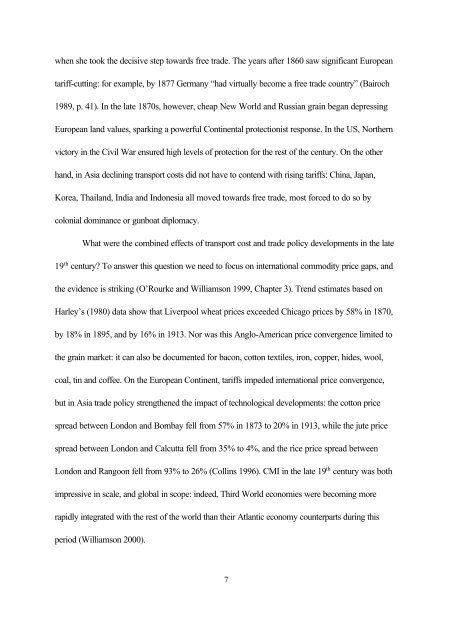Globalization and Inequality - Trinity College Dublin
Globalization and Inequality - Trinity College Dublin
Globalization and Inequality - Trinity College Dublin
You also want an ePaper? Increase the reach of your titles
YUMPU automatically turns print PDFs into web optimized ePapers that Google loves.
when she took the decisive step towards free trade. The years after 1860 saw significant European<br />
tariff-cutting: for example, by 1877 Germany “had virtually become a free trade country” (Bairoch<br />
1989, p. 41). In the late 1870s, however, cheap New World <strong>and</strong> Russian grain began depressing<br />
European l<strong>and</strong> values, sparking a powerful Continental protectionist response. In the US, Northern<br />
victory in the Civil War ensured high levels of protection for the rest of the century. On the other<br />
h<strong>and</strong>, in Asia declining transport costs did not have to contend with rising tariffs: China, Japan,<br />
Korea, Thail<strong>and</strong>, India <strong>and</strong> Indonesia all moved towards free trade, most forced to do so by<br />
colonial dominance or gunboat diplomacy.<br />
What were the combined effects of transport cost <strong>and</strong> trade policy developments in the late<br />
19 th century? To answer this question we need to focus on international commodity price gaps, <strong>and</strong><br />
the evidence is striking (O’Rourke <strong>and</strong> Williamson 1999, Chapter 3). Trend estimates based on<br />
Harley’s (1980) data show that Liverpool wheat prices exceeded Chicago prices by 58% in 1870,<br />
by 18% in 1895, <strong>and</strong> by 16% in 1913. Nor was this Anglo-American price convergence limited to<br />
the grain market: it can also be documented for bacon, cotton textiles, iron, copper, hides, wool,<br />
coal, tin <strong>and</strong> coffee. On the European Continent, tariffs impeded international price convergence,<br />
but in Asia trade policy strengthened the impact of technological developments: the cotton price<br />
spread between London <strong>and</strong> Bombay fell from 57% in 1873 to 20% in 1913, while the jute price<br />
spread between London <strong>and</strong> Calcutta fell from 35% to 4%, <strong>and</strong> the rice price spread between<br />
London <strong>and</strong> Rangoon fell from 93% to 26% (Collins 1996). CMI in the late 19 th century was both<br />
impressive in scale, <strong>and</strong> global in scope: indeed, Third World economies were becoming more<br />
rapidly integrated with the rest of the world than their Atlantic economy counterparts during this<br />
period (Williamson 2000).<br />
7
















